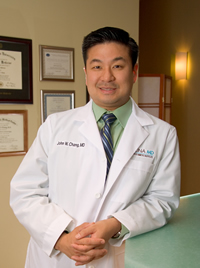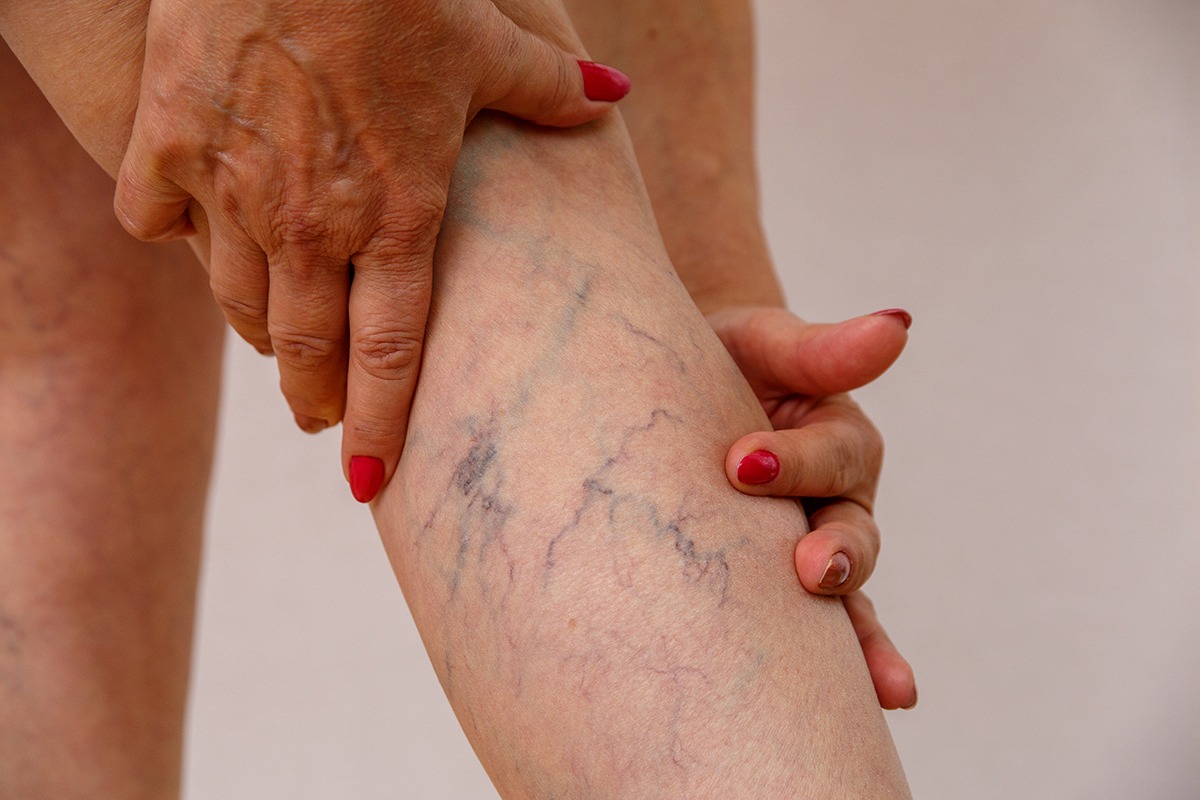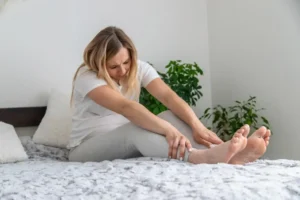| Spider veins are small, visible veins that can be caused by factors like genetics, aging, and lifestyle choices such as prolonged standing or sitting. Preventative measures, such as maintaining a healthy weight, exercising regularly, and wearing compression stockings, can help reduce the risk of developing spider veins. If they do appear, effective treatments like EVLT and sclerotherapy are available to minimize their appearance. Schedule a consultation with Miami Vein Institute in Coral Gables & Weston, Florida, to explore personalized treatment options and keep your legs healthy and beautiful. |
Spider veins are small, visible veins that appear near the surface of the skin. They often present as red, blue, or purple lines that resemble a spider’s web, hence their name. While spider veins are usually harmless, they can be unsightly and may cause discomfort or embarrassment for many individuals.
Fortunately, spider veins can often be prevented with healthy lifestyle choices, and if they do develop, there are effective treatments available to reduce their appearance.
At Miami Vein Institute in Coral Gables & Weston, Florida, we specialize in the treatment and prevention of spider veins. Our goal is to help patients maintain healthy, beautiful legs and address any concerns related to venous health.
In this blog, we will explore the causes of spider veins, their symptoms, and the steps you can take to prevent them. We will also discuss the available treatment options, including EVLT and sclerotherapy, which are highly effective in treating existing spider veins.
What Are Spider Veins?
Spider veins are small, damaged veins that appear on the surface of the legs, face, or other parts of the body. They are a mild form of varicose veins and typically do not cause serious health problems.
However, they can sometimes cause discomfort, including itching, burning, or aching in the affected area. Many people seek treatment for spider veins for cosmetic reasons, as the veins are often considered unattractive.
While spider veins are commonly found on the legs and face, they can develop in other areas as well. They form when blood vessels near the surface of the skin become damaged or weak, leading to blood pooling in the area.
This results in the characteristic web-like appearance. Although spider veins are typically harmless, they can sometimes indicate underlying circulation problems, making it important to monitor your venous health.
Causes and Risk Factors of Spider Veins
Spider veins develop for a variety of reasons, and understanding the causes and risk factors can help you take steps to prevent them. Genetics play a significant role in the development of spider veins.
If you have a family history of spider veins or varicose veins, you are more likely to develop them yourself. However, other factors, such as lifestyle choices and certain health conditions, can also increase your risk.
- Genetics: If your parents or close relatives have spider veins or varicose veins, you may have a genetic predisposition to developing them as well.
- Aging: As we age, the valves in our veins that help regulate blood flow can weaken, leading to blood pooling and the formation of spider veins.
- Prolonged standing or sitting: People who spend long periods of time either standing or sitting may experience reduced blood flow in their legs, increasing the risk of spider veins. This is especially common in individuals who work in professions that require long hours on their feet or at a desk.
- Hormonal changes: Hormonal fluctuations, particularly during pregnancy, puberty, or menopause, can increase the likelihood of developing spider veins. This is why women are more prone to spider veins than men.
- Obesity: Carrying extra weight puts additional pressure on the veins in your legs, making it more difficult for blood to flow efficiently. This can lead to blood pooling in the veins, contributing to spider vein development.
Understanding these causes and risk factors can help you identify whether you are at risk for spider veins and take proactive measures to prevent them.
Symptoms of Spider Veins to Watch Out For
Spider veins are often visible on the surface of the skin, making them easy to recognize. However, they may also cause certain symptoms that can indicate an underlying venous issue.
Knowing the symptoms to look out for can help you determine whether spider veins are developing and whether you should seek medical advice.
- Visible veins: Spider veins appear as small, red, blue, or purple veins that form web-like patterns near the surface of the skin. They are often found on the legs, face, and sometimes other areas of the body.
- Leg discomfort: Some people with spider veins may experience aching, heaviness, or fatigue in their legs, especially after standing or sitting for extended periods.
- Itching or burning: Spider veins can cause a mild burning or itching sensation in the affected area, particularly when they are located on the legs.
- Swelling: In some cases, spider veins may contribute to mild swelling in the ankles or lower legs, especially if they are accompanied by varicose veins.
If you notice any of these symptoms, it may be time to consult a specialist at Miami Vein Institute in Coral Gables & Weston, Florida, for an evaluation of your venous health.
Tips to Prevent Spider Veins
While some factors contributing to spider veins, such as genetics, cannot be controlled, there are several lifestyle changes you can adopt to help prevent them. By taking these steps, you can improve your circulation and reduce the likelihood of developing spider veins.
- Maintain a healthy weight: Carrying excess weight puts added pressure on your veins, especially in your legs. This pressure makes it harder for blood to flow properly, leading to pooling and the formation of spider veins. By maintaining a healthy weight through a balanced diet and regular exercise, you can reduce the strain on your veins and lower your risk of developing spider veins.
- Exercise regularly: Physical activity promotes healthy blood flow and strengthens the muscles that support your veins. When your muscles are strong, they help push blood back toward your heart, reducing the risk of blood pooling in the legs. Activities such as walking, swimming, and cycling are excellent choices for improving circulation and preventing spider veins.
- Wear compression stockings: Compression stockings are designed to apply gentle pressure to your legs, helping improve blood flow and prevent blood from pooling in the veins. They are particularly helpful for individuals who spend long periods sitting or standing, as they reduce the likelihood of spider veins forming by supporting healthy circulation.
- Avoid prolonged sitting or standing: When you sit or stand for extended periods, blood tends to pool in your legs, increasing the risk of spider veins. To promote healthy circulation, take breaks every 30 minutes to walk around or elevate your legs. If your job requires long hours at a desk, try incorporating standing breaks or walking around the office periodically.
- Elevate your legs when resting: Raising your legs above your heart while resting encourages blood to flow back toward your heart, reducing the pressure in your veins. This simple habit can improve circulation and help prevent spider veins from forming.
By following these preventive measures, you can support your vein health and reduce your risk of developing spider veins. These tips are especially important for individuals who are at higher risk due to genetics or lifestyle factors.
Treatment Options for Spider Veins: EVLT and Sclerotherapy
If you already have spider veins, there are effective treatment options available at Miami Vein Institute. Two of the most common treatments for spider veins are Endovenous Laser Therapy (EVLT) and Sclerotherapy. Both treatments are minimally invasive and can significantly reduce the appearance of spider veins.
Endovenous Laser Therapy (EVLT)
EVLT is a minimally invasive procedure that uses laser energy to close off spider veins and varicose veins. This treatment is particularly effective for veins that are larger or deeper beneath the skin’s surface.
During the procedure, a small laser fiber is inserted into the affected vein. Laser energy is then applied to the vein, causing it to heat up and collapse. Once the vein is sealed, blood is redirected to healthier veins, and the treated vein is gradually absorbed by the body.
- Minimally invasive: EVLT is a non-surgical procedure that requires only a small incision, leading to minimal scarring and quick recovery.
- Effective results: EVLT effectively reduces the appearance of spider veins and varicose veins, providing long-lasting results.
- Quick recovery time: Most patients can return to normal activities within a few days, making EVLT a convenient option for those with busy lifestyles.
Sclerotherapy
Sclerotherapy is a popular and effective treatment for spider veins, particularly smaller or more superficial veins. It involves injecting a sclerosing solution directly into the affected veins, causing them to collapse and fade over time.
A sclerosing agent is injected into the spider veins, which irritates the lining of the veins, causing them to close and be reabsorbed by the body. Over time, the veins fade, and the skin appears clearer and more even-toned.
- Non-surgical: Sclerotherapy is a non-surgical procedure that can be performed in a doctor’s office with minimal downtime.
- Highly effective: Sclerotherapy is one of the most effective treatments for spider veins, with many patients experiencing significant improvement after just one or two sessions.
- Minimal discomfort: The procedure is relatively quick and involves only mild discomfort, making it a comfortable option for most patients.
Aftercare Tips for Spider Vein Treatments
After undergoing treatment for spider veins, it’s important to follow aftercare instructions to ensure the best possible results.
This includes wearing compression stockings as recommended by your doctor to support healthy circulation and minimize the risk of new veins forming. You should also avoid strenuous activities for a few days following treatment to allow your body to heal properly.
Keeping your legs elevated when resting and avoiding prolonged sitting or standing will help promote healthy blood flow and prevent the recurrence of spider veins. Additionally, it’s essential to protect your skin from sun exposure by wearing sunscreen, as UV rays can cause further damage to the treated areas.
Why Choose Miami Vein Institute for Spider Vein Prevention in Coral Gables & Weston, Florida
Preventing spider veins is possible with healthy lifestyle choices and proactive care. By maintaining a healthy weight, exercising regularly, and avoiding prolonged sitting or standing, you can reduce your risk of developing spider veins and improve your overall vein health.
However, if spider veins do develop, treatments like EVLT and sclerotherapy offered at Miami Vein Institute provide effective solutions to reduce their appearance.
At Miami Vein Institute in Coral Gables & Weston, Florida, we specialize in preventing and treating spider veins using advanced, minimally invasive techniques. Our team of vein specialists is dedicated to helping you maintain healthy, beautiful legs and providing you with personalized care.
If you’re concerned about spider veins or want to learn more about prevention and treatment options, schedule a consultation with Miami Vein Institute today. Let us help you achieve healthy legs and a renewed sense of confidence.
Frequently Asked Questions (FAQ)
What are the early signs of spider veins?
Spider veins often appear as small, red, blue, or purple veins near the surface of the skin. If you experience discomfort or notice visible veins on your legs or face, it may be an early sign.
Are spider veins dangerous?
Spider veins are generally harmless, but they can sometimes indicate underlying circulation problems. It’s always a good idea to consult a specialist if you’re concerned.
Can spider veins be completely prevented?
While genetics play a role, following healthy lifestyle habits can significantly reduce your risk of developing spider veins.
What treatment options are available if spider veins do develop?
Treatment options such as EVLT and sclerotherapy are highly effective in reducing the appearance of spider veins.
How long does it take to recover from spider vein treatments?
Most patients can return to their normal activities within a few days, though it’s important to follow your doctor’s post-treatment care guidelines.

John W. Dr. Chang, MD, serves as the Partner and Medical Director at Miami Vein Institute, a premier center specializing in vein treatment in South Florida. With a focus on providing high-quality care and ensuring patient safety and satisfaction, Dr. Chang has helped establish Miami Vein Institute as a leading destination for minimally invasive vein treatments. At Miami Vein Institute, Dr. Chang offers a comprehensive range of minimally invasive procedures, including Endovenous Laser Treatments (EVLT) and Sclerotherapy, to address various vein-related concerns. His expertise in both general and cosmetic surgery, combined with specialized training in vein treatments, allows him to tailor treatment plans to meet each patient’s individual needs. Dr. Chang’s commitment to excellence is reflected in his meticulous attention to detail and dedication to staying updated with the latest advancements in vein care technologies. He is certified in a wide array of cosmetic surgery procedures and is a certified trainer for various advanced techniques. Dr. Chang’s affiliations with prestigious medical associations underscore his commitment to upholding the highest standards of medical excellence. With a focus on patient well-being and personalized care, Dr. Chang ensures that every patient receives honest, expert guidance throughout their treatment journey. His passion for providing the best possible care is evident in his commitment to patient satisfaction and achieving optimal outcomes.


